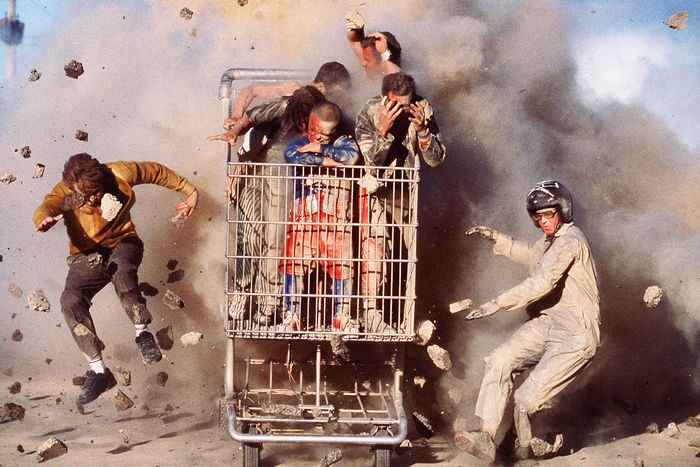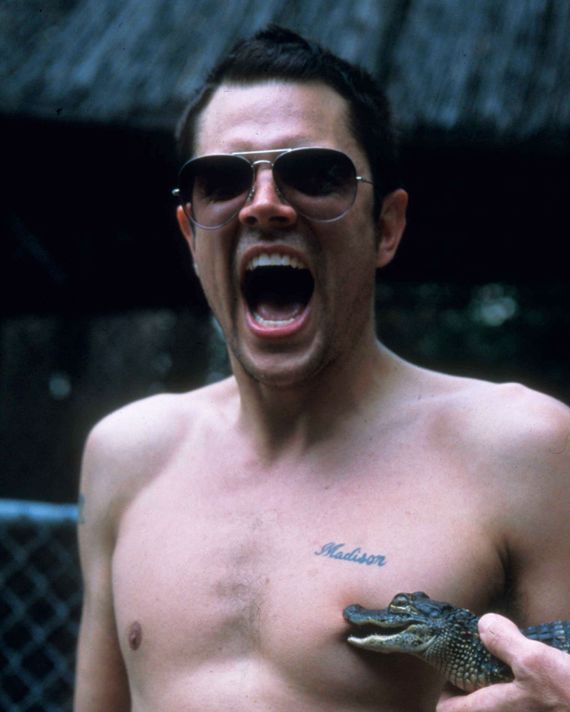
The very first scene of the very first Jackass movie offers a good encapsulation of the entire Jackass cinematic project. To the strains of Carl Orff’s Carmina Burana, the Jackass crew, crowded inside an extremely unsafe-looking oversize shopping cart, emerges from a wall of smoke and hurtles down a road wailing on each other. Bam Margera slams Johnny Knoxville atop the head. Ryan Dunn slaps the side of Margera’s face, and Margera retaliates by punching Dunn right back. Each strike seems extremely painful, with the victim cowering right afterward. Suddenly, cannons along the road start firing concrete bombs at our heroes, covering everyone in dust and sending Dave England and Preston Lacy tumbling away. The sheer glee with which everyone inflicts all this abuse on one another, combined with the clearly agonizing consequences, is the Jackass formula: pointless bravado leading to humiliation and pain. Oh, and then the shopping cart hits a crate and catapults them into a fruit stand, an airborne tangle of flailing limbs, thus completing the formula with its final element: camaraderie.
Before Jackass became a global sensation on MTV in 2000, stunt and daredevil work had been a source of wonder, provoking the viewer to marvel at the toughness of the human (usually male) body. Jackass did some of that, but it primarily allowed us to marvel at that same body’s (often hilarious) fragility. People get hurt in Jackass. They scream in pain. They bleed and they vomit and they shit themselves. Resilience and vulnerability are inextricably linked: Watching Knoxville get his nipple bitten by a baby alligator in the first Jackass film wouldn’t really be of much interest if we didn’t also see his mouth agape, yelping in excruciating pain. (“Aaargghhh! Oww, fuck! No, you’re twisting him, you’re fucking twisting him! Fuuuck, he’s got my nipple dude. He’s got my fucking nipple!”) Watching Steve-O shoot a firecracker out of his ass is incomplete without the inevitable kicking and shrieking that follow (“Like, an ember fell right into my cornhole, dude. I actually burned my butthole”).
No real Jackass stunt is complete without the requisite moment of foulmouthed agony that follows its completion or abandonment. Think of Dunn sticking a toy car into his anus and then trying to poop it out (“Fuck! Ohhh, that hurts so bad. Something broke. I’m bleeding.”) in the first movie. Or England getting a leech stuck to his testicles (“Please, just get it off me! Getitthefuckoffme. Aaaaggagggaaaaaaah!”) in Jackass Number Two. And let’s not forget Jackass 3D’s delightful, impossible-to-describe duo of “Poo Cocktail Supreme” and “Sweatsuit Cocktail,” both of which set off chain reactions of vomiting among the cast and crew and possibly even the audience. (“Give me your camera. You’re puking right on your lens.”)
Often, the aftermath is more fun to watch than the actual bit itself. The only reason to watch Margera get tossed into a trailer full of snakes is to see (and hear) his response. (“Dude, get me out! Don’t do this to me! Seriously, get me the fuck out! Get me out now. Dude, stop fucking with me! I fucking hate you guys!”) My favorite aftermath may be the one that follows the climactic prank in Jackass Number Two, which has Ehren McGhehey posing as a terrorist, unaware that he’s actually the one being pranked and that the cabdriver he’s trying to freak out will pretend to go homicidal in response. But that’s just one part of the gag. McGhehey also has a fake beard glued to his face made (unbeknownst to him) of the cast and crew’s collective pubic hair. (“Oh my god, dude, that sucked. Every time it gets worse and worse. Fuck! Shit! … Seriously, was the dick hair necessary?”)
Individually, each of these stunts or pranks would seem breathtakingly mean-spirited. But because the films ensure that every cast member watching and giggling at one comrade’s misfortune will soon get their own moment of cinematic disgrace, they become something sweet — a group journey of pain, vomit, and tears. As chief instigator and cheerleader, Knoxville is the one who most yuks it up at his friends’ misfortunes; he can get away with that because he saves the most dangerous stunts for himself, as when he famously got knocked out by the boxer Butterbean in the first movie and actually started snoring (or was it a death rattle?) before being driven, glassy-eyed, to the emergency room. (“Where we going, Knoxville?” “The hospital.” “Why are we doing that?” “I don’t know. Apparently, I have a big gash in my head, and I think I’m a little concussed.”)
Both Jackass the show and Jackass the movies start and end with a warning imploring viewers not to try these stunts at home. Of course, some impressionable viewers have done exactly that over the years, which has always seemed odd to me given that Jackass always shows the dreadful consequences of its heroes’ stupid, stupid actions. But maybe what people aspire to isn’t the idiocy of the stunt, or even the grotesque agony that ensues, but the sense of companionship and belonging that comes with the effort. The films have so effectively created a communal atmosphere that the audience often feels like a part of the Jackass team.
In a world where onscreen heroes have become more fantastical, with actors obtaining comic-book physiques through high-end training regimens and computer-generated enhancements, Jackass presents a more accessible aesthetic. Sure, these guys may all be pasty bros (at least until this latest film), but they come in all shapes and sizes. They look and feel real, and proudly so. As anyone who has watched even a little bit of this stuff can testify, nudity is pretty much obligatory, regardless of the nature of the stunts. Jockstraps, Speedos, thongs, and flailing dongs are the order of the day, with a bikini sometimes thrown in for good measure. The movies rub our faces in these bodies, in part to emphasize the inevitable suffering they will be subjected to but also to remind us that these bodies belong to real people.
And they get old, too. In the new film, Jackass Forever, Knoxville suffers probably his most brutal injury yet, thanks to an abortive magic trick played on a very angry bull. After passing out yet again, he gets stretchered off into an ambulance to the cheers and applause of his cast and crew. The stunt itself is, of course, ridiculously dangerous. (Knoxville revealed recently that he suffered brain damage from the encounter.) But it’s in keeping with the overall mood of the new film. If, in the past, we tensed up waiting for the inevitably gruesome results of individual stunts, this time the fear of pain and suffering and injury hangs over every inch of the picture. Because even though the team has been reinforced with younger, admirably game collaborators, those familiar faces from before have become middle-aged men, many of them quite the worse for wear. (And some are, sadly, missing: Margera is no longer with the team, reportedly due to substance-abuse issues. Dunn was tragically killed in a drunk-driving accident in 2011.) Steve-O shows us his fake tooth and, at one point, vomits it out. And then there’s Knoxville’s hair. He recently told GQ that he started graying at a very young age and that has been diligently dying it all these years, only to stop during the pandemic. Whatever his reasons, the visual effect is a perfect cinematic touch — as if Knoxville’s hair suddenly turned white from all the abuse his body had endured. The spectacle of watching this broken-down crew go about their stunts gives the movie an elegiac quality, forcing us to reflect on our own mortality.
“Nobody wants to see me die,” Knoxville’s hero, the American daredevil Evel Knievel, liked to say. “But they don’t want to miss it if I do.” Knievel gained fame and notoriety in the 1970s for attempting seemingly impossible feats with his motorcycle: jumping 13 Pepsi trucks on the Yakima Speedway, nine cars and one van at Madison Square Garden, or 14 Greyhound buses at Kings Island theme park. He didn’t always succeed, and his smash-ups were often as magnificent as his successes. Much of his early fame came from his crash-landing after jumping the fountains at Caesars Palace in 1967, and he notoriously failed to traverse Idaho’s Snake River Canyon in 1974, when the rocket he was strapped to malfunctioned.
Knievel didn’t become a household name just because of what he did, or even what he failed to do. In the 2015 documentary Being Evel, which Knoxville produced, he asserts that Knievel’s antics connected with a nation dancing on the knife’s edge of chaos. Evel dressed in red, white, and blue and turned his events into flag-waving, patriotic spectacles with the national anthem playing beforehand. His flamboyant derring-do — an all-American concoction of bravery and know-how — offered an escape during a period of great social, political, and economic turmoil, and his lone-man-against-the-laws-of-physics aura came straight out of the country’s idealized vision of itself.
Knoxville has paid homage to his hero multiple times but only in the most ironic ways. On the second season of Jackass, in a bit called “Snake River BMX,” Dunn attempts to ride a malfunctioning bike across two rickety wooden planks set on either side of a filthy sewage runoff drain and is repeatedly tripped up, until the cops come and arrest everybody. (“You smell like the inside of an ass!”) In Jackass 3D, he attempts the jump again, this time across a proper creek, wearing an Evel Knievel outfit and riding an even wobblier, smaller bike. (“That thing is squirrelly as fuck!”) In Jackass Number Two, Knoxville, again in full-on Evel regalia, complete with a white cape, attempts to launch himself in a big red rocket over a lake. Much like Knievel’s, his rocket malfunctions the first time and nearly kills him. So he tries again — even though the rocket’s main purpose was always just to crash. (“Even if the rocket doesn’t blow up on me this time, there are not a lot of great ways for it to end anyway.”)
If Knievel represented a dream, Jackass perhaps represents the world after the end of that dream: an America of crumbling infrastructure, poor decisions, and spectacular miscalculations. An America where shit just goes wrong all the time. No, it’s more than that: an America where we expect shit to go wrong all the time. The movies turn that failure on its head by foregrounding the agony of defeat, by making the bodily abuse and the ensuing screaming and vomiting the main event. Over and over in Jackass, ramps fail, bikes wobble, stuff collapses, and people bleed. They have to. It would be no fun if they didn’t. Knievel provided catharsis by jumping gauntlets of Mack trucks in massive stadiums; Knoxville and his pals provide catharsis by letting dogs bite them in the ass (“Owwww! Oklahoma! Oklahoma! Ahhh, fuck! My ass meat!”) and by trapping each other in limousines full of bees. (“Oh, dude, it hurts. Ayyaaggah! Please put me somewhere where there’s no bees!”) They take our despairing reality and turn it into entertainment by presenting a vision of loyalty and fellowship. The world is fucked and everything hurts, they seem to say, but at least we have each other.



